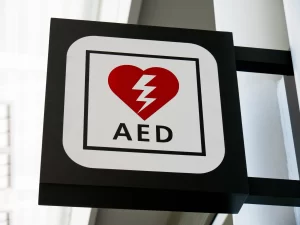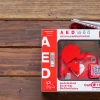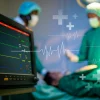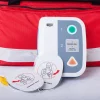
Recent Post
- What Maintenance Is Required for an AED: Everything You Need To Know
November 14, 2025  Could You Recognise the Signs That Someone Needs a Defibrillator?
Could You Recognise the Signs That Someone Needs a Defibrillator?
September 12, 2023
Introduction
Did you know that every year in Australia, approximately 30,000 people suffer a sudden cardiac arrest out of hospital? Shockingly, only 10% of these victims survive. A delay in receiving lifesaving treatment plays a significant role in this grim statistic. Here’s where Automated External Defibrillators, or AEDs, come into the picture.
Understanding AED and AED Wall Signs
An AED is a portable electronic device that can automatically diagnose potentially life-threatening heart conditions like arrhythmias. If needed, it delivers a shock to the heart, helping restore a normal rhythm. So, the AED isn’t just a piece of medical equipment; it’s a beacon of hope when every second counts.
Just as crucial as the AED itself is the AED wall sign. It guides both medical professionals and laypeople to this lifesaving device. By making AEDs quickly identifiable, these signs increase the likelihood that they’re used during medical emergencies.
Legal Requirements for AEDs in Australia
While there’s no federal mandate requiring AEDs in all public buildings across Australia, some states have established their own laws. For example, New South Wales has required certain types of public venues to have AEDs since 2020. Non-compliance with these laws can result in hefty penalties, a crucial motivation for public buildings to follow the health and safety law.
Impact of AEDs on Survival Rates
Let’s get down to the heart of the matter: survival rates. Several studies have shown a significant increase in survival rates when AEDs are used promptly. For instance, a bystander’s use of an AED before medical personnel arrive can double or even triple a victim’s chances of survival. Hearing real-life stories, testimonials if you like, of AEDs saving lives, is nothing short of heart-warming.
Improving Public Awareness about AEDs
It’s time we got the word out about AEDs. Even with AEDs and their signs in public places, they’re no good if people don’t know how to use them. AED wall signs act as a constant visual reminder, sparking curiosity and encouraging people to learn about these devices. From community workshops to online tutorials, public campaigns and initiatives can go a long way in educating the masses.
Making AEDs and AED Wall Signs More Accessible
Accessibility is the name of the game. Having AEDs tucked away in obscure corners won’t cut it. The AED wall signs need to be visible from a distance, and the AEDs themselves within reach. If a picture paints a thousand words, a well-placed sign can save a thousand lives.
Government and non-profit organisations have a significant role to play here. From increasing the number of AEDs in public buildings to creating more accessible AED wall signs, they can turn the tide in this public health challenge.
Case Study – Public Buildings Excelling in AED Implementation
Success stories? We have plenty. Take the example of the Queen Victoria Building in Sydney. They’ve not only installed AEDs but also made sure they’re clearly marked with visible wall signs. And it’s paying off. There have been incidents where prompt access to these AEDs has made the difference between life and death.
Making Safety a Priority with Priority First Aid
At Priority First Aid, we believe in empowering you to handle medical emergencies confidently.
Comprehensive Range of AEDs
We offer a wide selection of Automated External Defibrillators (AEDs), ensuring you have access to the most suitable lifesaving device for your needs.
High-Visibility AED Wall Signs
Our highly visible AED wall signs enable rapid identification and access to AEDs, crucial during emergencies when every second counts.
AED Training and Awareness
We don’t just supply AEDs; we also provide comprehensive AED training. We’re committed to raising public awareness about AEDs, equipping Australians with the skills to respond effectively in a cardiac arrest scenario.
Conclusion
In conclusion, every public building in Australia should have an AED wall sign. The device is a lifesaver, and its wall sign, the guiding light. It’s not just about complying with the law. It’s about giving cardiac arrest victims a fighting chance. Let’s not drop the ball on this one, mates. Together, we can make our public spaces safer, one AED wall sign at a time.
1. Q: What exactly is an Automated External Defibrillator (AED)?
A: An Automated External Defibrillator, or AED, is a portable medical device that can assess a person’s heart rhythm. If it detects a problem that may lead to sudden cardiac arrest, such as ventricular fibrillation, the AED can send an electric shock to the heart to try to restore its normal rhythm. They’re designed to be simple to use for the layperson, making them a vital tool in the fight against cardiac arrest.
2. Q: Why are AED wall signs important in public buildings?
A: AED wall signs play a crucial role in increasing the visibility and accessibility of AEDs. These signs can quickly guide anyone, including those unfamiliar with the building layout, towards the lifesaving device during an emergency. Considering that every second counts during cardiac arrest, the prompt use of an AED can significantly increase survival rates.
3. Q: Are there any legal requirements for AEDs in Australia?
A: As of my last update in September 2021, Australia doesn’t have a nationwide law requiring all public buildings to have AEDs. However, individual states and territories may have their own laws and regulations regarding this. For instance, New South Wales requires certain public venues to have AEDs. It’s always best to check the latest local regulations for the most accurate information.
4. Q: How can we increase public awareness about AEDs?
A: Public awareness about AEDs can be improved through educational campaigns, public initiatives, and training programmes. These may include community workshops, online tutorials, or demonstrations in public places. In addition, clear AED wall signs also serve to increase awareness, sparking curiosity and encouraging individuals to learn more about how these devices work and how they can potentially save lives.




